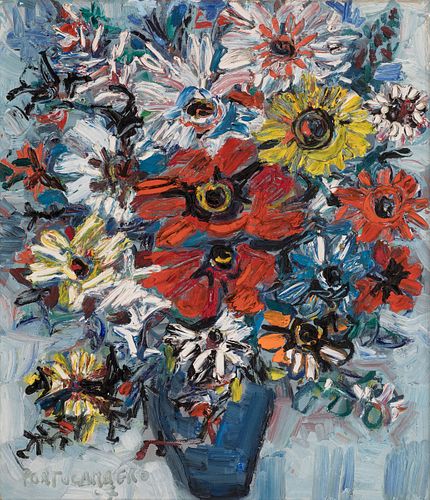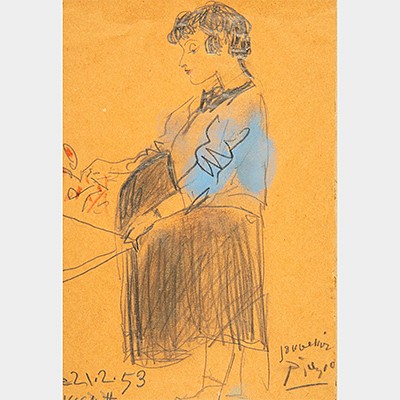RENÉ PORTOCARRERO (El Cerro, Cuba, 1912 - Havana, Cuba, 1985). "Flower vase", 1967. Oil on canvas. Attached certificate issued by the Cuban Art Founda
Lot 82
About Seller
Setdart Auction House
Carrer Aragó 346
Barcelona
Spain
Setdart Subastas was born in 2004 and is currently the first online art auction in Spain with solidity, prestige and reliability guaranteed by our more than 60,000 users. Setdart has a young, dynamic and enterprising team ready to successfully manage the purchase and sale of art works through custom...Read more
Estimate:
EUR€35,000 - EUR€40,000
$38,043.48 - $43,478.26
Absentee vs Live bid
Two ways to bid:
- Leave a max absentee bid and the platform will bid on your behalf up to your maximum bid during the live auction.
- Bid live during the auction and your bids will be submitted real-time to the auctioneer.
Bid Increments
| Price | Bid Increment |
|---|---|
| EUR€0 | EUR€10 |
| EUR€200 | EUR€25 |
| EUR€500 | EUR€50 |
| EUR€1,000 | EUR€100 |
| EUR€3,000 | EUR€200 |
| EUR€5,000 | EUR€500 |
| EUR€10,000 | EUR€1,000 |
| EUR€20,000 | EUR€2,000 |
| EUR€50,000 | EUR€5,000 |
About Auction
By Setdart Auction House
Sep 20, 2021
Set Reminder
2021-09-20 08:00:00
2021-09-20 08:00:00
America/New_York
Bidsquare
Bidsquare : CONTEMPORARY ART
https://www.bidsquare.com/auctions/setdart-auction-house/contemporary-art-7482
Setdart Auction House sofia@setdart.com
Setdart Auction House sofia@setdart.com
- Lot Description
RENÉ PORTOCARRERO (El Cerro, Cuba, 1912 - Havana, Cuba, 1985). "Flower vase", 1967. Oil on canvas. Attached certificate issued by the Cuban Art Foundation. Work inscribed in the Catalogue of works of the Cuban Art Foundation. Ref: POR-157. Signed in the lower left corner. Measurements: 61 x 51 cm; 78 x 68 cm (frame). In this work the author uses a language of post-impressionist heritage to approach a traditional theme in art since the baroque, the painting of flowers. However, the approach to the subject is totally modern; the space disappears, the vase becomes a stain of colour and the flowers constitute an explosion of light and colour contained by a thick, dark, almost calligraphic stroke. This work, produced in 1967, belonged to the private collection of the undersecretary of commerce and minister of trade, Faustino García Moncó. The piece came to this collection as a personal gift from Fidel Castro to the minister as a token of his friendship. Of Spanish origin, Faustino García was a Spanish jurist, lawyer and politician. He studied law during the Spanish Civil War, in which he was actively involved on the rebel side. He was awarded the Campaign Medal, the Cross of Military Merit and the Croix de Guerre. During the Franco regime he worked as a State lawyer and as assistant director of the Banco de Bilbao. It was in 1957 that he became Undersecretary of Commerce and later Minister. René Portocarrero is best known for his colourful abstract paintings, although he was also a sculptor, ceramist, stage designer, muralist and book illustrator. He began painting at a very young age, and at the age of fourteen he entered the San Alejandro Academy of Fine Arts. However, he soon dropped out of his studies, as his strong temperament did not fit in with the rules of the institution. His training thereafter was self-taught. He exhibited his work for the first time at the Salón de Bellas Artes in Havana, and in 1934 he held his first personal exhibition at the Lyceum in the same city. The success of this exhibition was a great boost to his career, which enabled him to work at the Estudio Libre para Pintores y Escultores de La Habana (Free Studio for Painters and Sculptors of Havana), together with Mariano Rodríguez. Linked to the generation of poets of the so-called "Grupo de Orígenes", he published drawings in several literary magazines of the time, as well as two books. In 1943 he became a teacher of free drawing at the Havana Prison, and during these years he began several cycles of paintings. The following year he exhibited his work in New York at the Julian Levy Gallery and the Museum of Modern Art. He also began several trips that took him to paint in Haiti, Europe and the United States. Around 1950 he began to work on the decoration of ceramic pieces at the Taller Experimental de Santiago de Las Vegas, alongside other artists such as Wifredo Lam, Amelia Peláez and Mariano Martínez. In 1951 he received the National Painting Prize for the first of his so-called "Havana Landscapes". He participated in the São Paulo Biennial in 1957 and 1963, and in the Venice Biennial in 1952 and 1966. Throughout his career, Portocarrero received numerous prizes and distinctions, including the Sambra International Prize (São Paulo Biennial, 1963), etc. In 1985, the year of his death, he held a travelling exhibition with a large part of his work, which toured several European countries and definitively consolidated his already internationally recognised artistic legacy. René Portocarrero is currently represented in major centres of artistic relevance, including the MoMA in New York, the National Museums of Fine Arts in Havana, Santiago de Chile and Argentina, the Spanish Museum of Contemporary Art, the Museum of Modern Art in São Paulo, the Museum of Contemporary Art in Santiago de Chile and many others, as well as in important private collections.
- Shipping Info
-
In-house shipping available. Please inquire at admin@setdart.com.
-
- Buyer's Premium



 EUR
EUR CAD
CAD AUD
AUD GBP
GBP MXN
MXN HKD
HKD CNY
CNY MYR
MYR SEK
SEK SGD
SGD CHF
CHF THB
THB

















